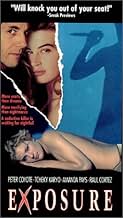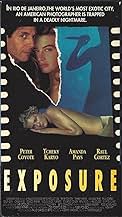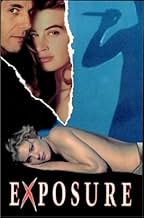CALIFICACIÓN DE IMDb
6.1/10
815
TU CALIFICACIÓN
Agrega una trama en tu idiomaAn American photographer in Rio de Janeiro becomes involved in the world of "knife culture" when he sets out to find the killer of one of his models.An American photographer in Rio de Janeiro becomes involved in the world of "knife culture" when he sets out to find the killer of one of his models.An American photographer in Rio de Janeiro becomes involved in the world of "knife culture" when he sets out to find the killer of one of his models.
- Dirección
- Guionistas
- Elenco
- Premios
- 4 premios ganados en total
Tchéky Karyo
- Hermes
- (as Tcheky Karyo)
José René Ruiz
- José Zakkai - Iron Nose
- (as Rene Ruiz)
Miguel Ángel Fuentes
- Camilo Fuentes
- (as Miguel Angel Fuentes)
Cássia Kis
- Mercedes
- (as Cassia Kiss)
Alvaro Freire
- Evilásio - Mitry's Butler
- (as Álvaro Freire)
Opiniones destacadas
A film that is extremely evocative - so many exciting nuances. It is unforgettable - a pity that the actor who played the "knife expert" is seen more. One of Peter Coyote's best.An unusual cast - many contrasts. The photography is outstanding. A haunting experience....
The path of a pacifist photographer being seduced by the need for justice and the intrigue of a hitherto unknown world of professional assassins plying their trade via the intimate and all-too-personal death delivered by a knife is a very deep experience to watch unfold, and Peter Coyote does it to a tee.
His inner revulsion to the horror of embracing this culture is offset by its fascination as well as the necessity of descending into it to find out the truth behind the killing of model/prostitutes. Slowly but surely you observe the influence of his gaining knowledge and confidence as he is tutored (by a master of the art he just happens to see and captures on camera one day plying his craft), all dragging him down to dive in completely.
The plot thickens as characters are revealed and surprises are forthcoming, all leading to a fantastic final knife-fighting confrontation with the acknowledged master, someone he has known all along but not suspected.
I saw this movie about 10 years ago, but never noted the title until I was trying to order it on-line, and now I have it in my collection. I highly recommend it for its combination of intense drama, revealing close analysis of the process of a sworn pacifist turned to embrace violence as a way of life, amazing fighting scenes, and an uplifting ending. Unforgettable.
His inner revulsion to the horror of embracing this culture is offset by its fascination as well as the necessity of descending into it to find out the truth behind the killing of model/prostitutes. Slowly but surely you observe the influence of his gaining knowledge and confidence as he is tutored (by a master of the art he just happens to see and captures on camera one day plying his craft), all dragging him down to dive in completely.
The plot thickens as characters are revealed and surprises are forthcoming, all leading to a fantastic final knife-fighting confrontation with the acknowledged master, someone he has known all along but not suspected.
I saw this movie about 10 years ago, but never noted the title until I was trying to order it on-line, and now I have it in my collection. I highly recommend it for its combination of intense drama, revealing close analysis of the process of a sworn pacifist turned to embrace violence as a way of life, amazing fighting scenes, and an uplifting ending. Unforgettable.
10scvanv
Fighting with edged weapons fell into obscurity after the advent of the gun. The old European blade skills almost died out, as did the Oriental arts of Arnis, Escrima, and Silat(which were derived in part from the fighting art of the Spanish Conquistadors).
The science of blade fighting smoldered weakly for five hundred years in remote outposts of Indonesia, the Philippines and Japan where the gun never quite captured the imagination of peoples who had truly understood steel.
Recently, for reasons which are still obscure, blade skills have enjoyed a renaissance as a legitimate martial art in the United States. A sub-culture of knife fighting students has emerged which will be the audience of this excellent movie.
This film stands almost alone as an artistic representation of training and fighting with edged weapons. Early in the movie Tcheky Karyo carries off a chilling and realistic knife-fighting sequence which makes the hair stand up on the neck. He then plays the instructor, showing the viewer the simple beauty of how an art thousands of years old can be transmitted.
Peter Coyote makes us see the mental and physical journey of the student. At the climax of the movie he manages to project truly the mind-set needed to face steel with steel as he goes toe-to-toe with the true master in a duel to the death.
The training sequences in this movie are clear expressions of real techniques used in the old arts of Arnis and Escrima, with elements of European blade practice thrown in. The film could actually be studied as a training aid.
A certain amount of "Hollywood" was included to extend the final fighting sequence for dramatic effect, but this will not be noticed by the novice and should not interfere with the enjoyment of any viewer interested in the arts involved.
This film is an example of the movie being better than the book. Rubim Fonseca's book "The High Art" contained only the germ of the grim plot which the movie fully exploits. For some reason, after having his character learn the high art, Fonseca has him put the knife away in a drawer and back away from the brutal reality of the science he has learned, contenting himself with amorous conquests rather than the quest for vengeance which was the real core of the book.
This movie will have a limited but loyal audience for many years. It is sad that there will probably never be a DVD version in which the frames could be stopped to better understand the science involved.
The science of blade fighting smoldered weakly for five hundred years in remote outposts of Indonesia, the Philippines and Japan where the gun never quite captured the imagination of peoples who had truly understood steel.
Recently, for reasons which are still obscure, blade skills have enjoyed a renaissance as a legitimate martial art in the United States. A sub-culture of knife fighting students has emerged which will be the audience of this excellent movie.
This film stands almost alone as an artistic representation of training and fighting with edged weapons. Early in the movie Tcheky Karyo carries off a chilling and realistic knife-fighting sequence which makes the hair stand up on the neck. He then plays the instructor, showing the viewer the simple beauty of how an art thousands of years old can be transmitted.
Peter Coyote makes us see the mental and physical journey of the student. At the climax of the movie he manages to project truly the mind-set needed to face steel with steel as he goes toe-to-toe with the true master in a duel to the death.
The training sequences in this movie are clear expressions of real techniques used in the old arts of Arnis and Escrima, with elements of European blade practice thrown in. The film could actually be studied as a training aid.
A certain amount of "Hollywood" was included to extend the final fighting sequence for dramatic effect, but this will not be noticed by the novice and should not interfere with the enjoyment of any viewer interested in the arts involved.
This film is an example of the movie being better than the book. Rubim Fonseca's book "The High Art" contained only the germ of the grim plot which the movie fully exploits. For some reason, after having his character learn the high art, Fonseca has him put the knife away in a drawer and back away from the brutal reality of the science he has learned, contenting himself with amorous conquests rather than the quest for vengeance which was the real core of the book.
This movie will have a limited but loyal audience for many years. It is sad that there will probably never be a DVD version in which the frames could be stopped to better understand the science involved.
I believe this oddly successful film was also aired on US television (Bravo channel) as "Exposure". I have never seen it under the other titles listed. The knife techniques are very professional and effective, as is the explanation of selection of weapons.
When I saw this movie I thought it was the renaissance of the Brazilian Cinema. I was wrong.
Anyways this movie I consider one of the best of Walter Salles. A movie the He himself doesn't even like to talk about it, because of a lots of studios interference.
The photographer, José Roberto Eliezer, should be awarded for the first sequence of this movie.
It's a very good Brazilian cast and I, with 16 years old, believed that I was watching movie by Brazilwood.
I guess I reached 10 lines.
Anyways this movie I consider one of the best of Walter Salles. A movie the He himself doesn't even like to talk about it, because of a lots of studios interference.
The photographer, José Roberto Eliezer, should be awarded for the first sequence of this movie.
It's a very good Brazilian cast and I, with 16 years old, believed that I was watching movie by Brazilwood.
I guess I reached 10 lines.
¿Sabías que…?
- TriviaFeature directorial debut for documentary filmmaker Walter Salles Jr.
- ErroresThe knife dealer says the Applegate-Fairbairn knife is used by British commandos. Actually the knife is a redesign of the Fairbairn-Sykes fighting knife that was widely used in WWII, the Applegate-Fairbairn wasn't issued to any armed forces to this day.
- Citas
Peter Mandrake: All my life, I've been looking for something... different.
- Versiones alternativasUK versions are cut by 19 seconds for an '18' rating.
- ConexionesFeatured in Logos de Todo el Mundo: United States of America (aka 'Murica) (2016)
- Bandas sonorasThe Photographer (A Gentleman's Honor)
Written and Arranged by Philip Glass
Orchestra conducted by Michael Riesman
Courtesy of CBS Records
Selecciones populares
Inicia sesión para calificar y agrega a la lista de videos para obtener recomendaciones personalizadas
- How long is A Grande Arte?Con tecnología de Alexa
Detalles
Taquilla
- Total en EE. UU. y Canadá
- USD 356,825
- Tiempo de ejecución1 hora 44 minutos
- Color
- Mezcla de sonido
- Relación de aspecto
- 1.85 : 1
Contribuir a esta página
Sugiere una edición o agrega el contenido que falta

Principales brechas de datos
What is the Spanish language plot outline for Pelea de navajas (1991)?
Responda



























